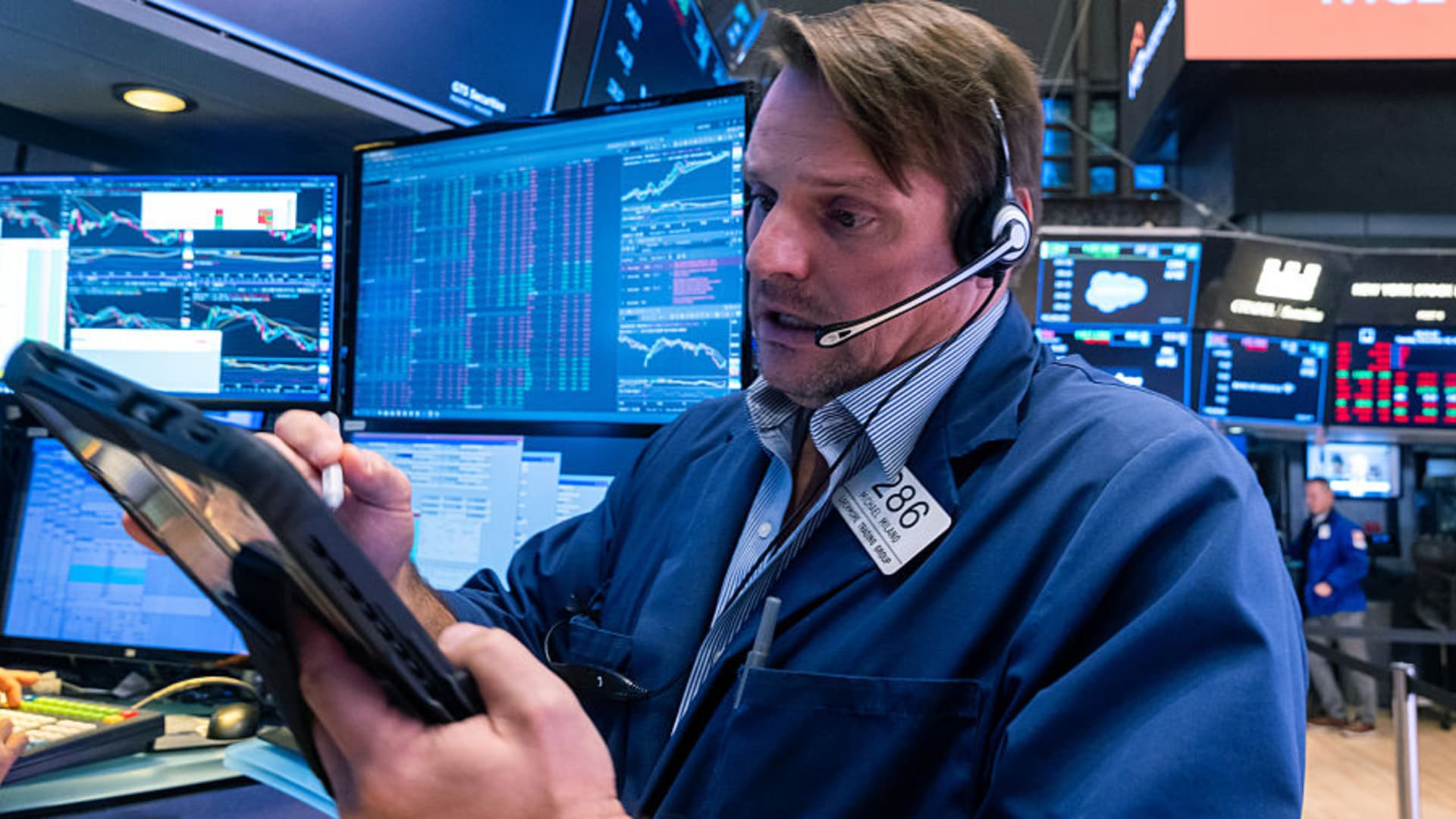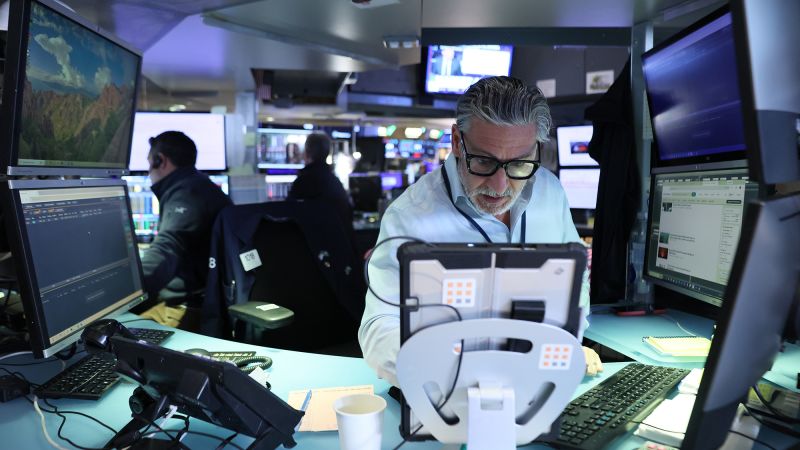Wall Street’s Tumultuous Tuesday: A Deep Dive into Market Anxiety and the AI Conundrum
The global financial markets found themselves gripped by a palpable sense of apprehension this Tuesday, as major indices across Wall Street experienced a significant downturn. Investors grappled with a confluence of anxieties, primarily centered on the red-hot artificial intelligence sector and broader macroeconomic uncertainties. The Dow Jones Industrial Average, a bellwether for the industrial economy, shed a substantial 557 points, translating to a 1.18% decline by the closing bell. This sharp pullback contributed to the S&P 500’s fourth consecutive day of losses, painting a grim picture for those hoping for a swift rebound.
At the heart of this market tremor lies a growing unease about what many are now openly questioning as an ‘AI bubble’. For months, the narrative surrounding artificial intelligence has been one of unbridled growth and transformative potential, driving valuations of related companies to unprecedented heights. This surge has been a primary engine of market gains over the past year. However, Tuesday’s sharp sell-off in tech shares, particularly those associated with AI, indicates a significant shift in investor sentiment. Skepticism is mounting regarding the sustainability of these stratospheric valuations, prompting a critical re-evaluation of whether current prices truly reflect fundamental value or are simply a product of speculative exuberance.
The Tech Sector’s Reckoning: Unpacking the AI Valuation Dilemma
The tech sector has been the undisputed champion of this bull run, with innovations in AI promising to reshape industries from healthcare to finance, logistics to entertainment. Companies like Nvidia, a critical supplier of the chips that power AI, have seen their market capitalizations explode, becoming some of the most valuable corporations globally. Yet, as history often reminds us, periods of intense technological enthusiasm can sometimes lead to market excesses.
“The current market dynamics bear a striking resemblance to previous tech booms,” observed Dr. Eleanor Vance, a veteran economist specializing in market cycles. “While the underlying technology of AI is undeniably revolutionary, the speed and scale of recent capital flows into AI-centric stocks have created an environment ripe for speculation. When the market reaches such fever pitch, any negative catalyst, or even just a lack of new overwhelmingly positive news, can trigger a sharp correction as investors question the long-term earnings potential against current, often inflated, prices.”
Tuesday saw a widespread retreat across the technology landscape. From software developers leveraging AI to cloud providers hosting AI models and hardware manufacturers producing AI components, the selling pressure was broad-based. This collective movement suggests that investors are not merely taking profits from a few over-extended stocks but are instead re-assessing the entire sector’s valuation framework. The era of ‘growth at any cost’ appears to be giving way to a more discerning approach, where profitability and sustainable business models are coming back into sharper focus.
Bitcoin’s Tumble: A Barometer for Risk-Off Sentiment
Adding another layer of jitters to the already anxious market, Bitcoin, the world’s largest cryptocurrency, briefly dipped below the significant $90,000 threshold. While often considered a distinct asset class, insulated from traditional market forces, Bitcoin’s recent price action has shown an increasing, albeit complex, correlation with broader risk appetite. Its brief fall on Tuesday mirrored the broader market’s retreat from speculative assets, signaling a widespread ‘risk-off’ attitude among investors.
- The cryptocurrency market, particularly Bitcoin, has demonstrated heightened sensitivity to shifts in global investor sentiment.
- When traditional equities, especially high-growth tech stocks, experience corrections, capital often flows out of perceived riskier assets like Bitcoin.
- This movement suggests that institutional investors, who now have significant exposure to Bitcoin via ETFs and direct investments, are rebalancing portfolios in response to market volatility.
- The $90,000 level held psychological importance for many crypto enthusiasts, and its breach, however temporary, sent a clear signal of increased selling pressure.
The synchronicity between the tech stock slide and Bitcoin’s dip underscores the growing interconnectedness of disparate asset classes in the modern financial ecosystem. What might have once been considered an uncorrelated hedge by some, now appears to be increasingly susceptible to the same forces driving sentiment in the equity markets. This entwining means that a speculative bubble, real or perceived, bursting in one domain can trigger powerful ripple effects across others, creating a cascade of uncertainty.
Nvidia’s Looming Shadow: A Defining Moment for the AI Era
The financial world now holds its collective breath, its gaze firmly fixed on Nvidia (NVDA), the semiconductor titan whose upcoming earnings report is widely anticipated to be a pivotal event for the entire AI industry. Nvidia’s graphics processing units (GPUs) are not merely components; they are the literal engines powering the artificial intelligence revolution, indispensable for everything from complex data center operations to the training of sophisticated large language models. Consequently, Nvidia’s financial performance is viewed not just as a reflection of its own corporate health, but as a critical, real-time barometer for the sustainability and trajectory of the entire AI sector.
The stakes could not be higher. Should Nvidia deliver a robust earnings report, showcasing strong revenue growth and providing optimistic forward guidance, it could serve as a powerful antidote to the current market jitters. Such an outcome might reassure investors that the fundamentals underpinning the AI boom remain solid, potentially halting the slide and even sparking a broader market rebound. Conversely, any hint of weakness – whether it be disappointing sales figures, a cautious outlook on future demand, or concerns about mounting competition and inventory levels – could catastrophically validate the burgeoning fears of an AI bubble. Such a scenario would likely exacerbate the current sell-off, pushing tech stocks further into correction territory and deepening the prevailing market anxiety.
Broader Economic Headwinds: Unmasking the US Economy’s Vulnerabilities
Beyond the immediate tech and crypto anxieties, a more pervasive undercurrent of concern regarding the broader US economy continues to exert pressure on markets. The recent announcement of shutdown-delayed jobs data has introduced an unwelcome layer of ambiguity, making it significantly harder for economists, analysts, and policymakers to accurately gauge the nation’s economic health. A robust and clear picture of the job market is typically a cornerstone indicator of consumer strength and overall economic resilience. However, any uncertainty surrounding these vital labor market statistics can rapidly fuel apprehension and lead to more cautious investment decisions.
Investors are currently attempting to navigate a remarkably complex macroeconomic landscape. This includes persistent and elevated inflation concerns, which continue to influence the Federal Reserve’s stance on future interest rate adjustments. The impact of these higher rates on corporate earnings, consumer borrowing, and overall spending patterns remains a significant watch point. Furthermore, lingering geopolitical tensions and the unpredictable nature of global supply chains add further layers of risk. When these formidable macroeconomic factors are combined with acute sector-specific worries, particularly in high-growth areas like technology, they create an exceptionally fertile ground for “risk-off” attitudes to become dominant, culminating in widespread selling pressure across virtually all asset classes.
- Ongoing inflationary pressures globally continue to challenge central bank policies.
- The delicate balance between controlling inflation and avoiding a recession remains precarious.
- Geopolitical flashpoints, from trade disputes to regional conflicts, invariably introduce unforeseen market volatility.
- Consumer confidence and spending habits, often dictated by economic stability, are under intense scrutiny.
The Psychology of the Market: Nerves Fray Ahead of Key Disclosures
In many respects, the current market environment is as much a psychological battleground as it is a fundamental one. The phrase “nerves fray ahead of Nvidia earnings” perfectly encapsulates the prevailing sentiment. During periods of elevated uncertainty, the collective behavior of investors frequently undergoes a notable shift: the pervasive ‘fear of missing out’ (FOMO) that defines bull markets often gives way to a more cautious, even anxious, ‘fear of holding on’ (FOHO). This psychological pivot leads to preemptive selling as investors, rather than risk being caught off-guard by potentially negative news, actively attempt to de-risk their portfolios.
This phenomenon of pre-event jitters is a well-established pattern in financial markets. Major corporations like Nvidia, given their outsized influence on specific sectors and, by extension, the broader market, invariably become lightning rods for this collective anxiety. The market, in essence, endeavors to ‘price in’ every conceivable outcome – positive, negative, and neutral – long before the actual news is disclosed. This anticipatory behavior often results in exaggerated price movements, both up and down, as participants attempt to position themselves optimally. It transforms the period leading up to such key disclosures into a tense, high-stakes waiting game, where every minor fluctuation in stock prices is meticulously scrutinized for clues regarding the market’s imminent direction.
Looking Ahead: Navigating the Labyrinth of Uncertainty
The immediate future promises to be a period of intense scrutiny and potential volatility for global financial markets. Beyond the critical Nvidia earnings report, market participants will be meticulously observing a range of other crucial data points and policy signals. Clarity on the delayed jobs data, further indicators of inflation trends, and any pronouncements from central banks regarding future monetary policy will be paramount. The intricate interplay of these macro-level factors with ongoing sector-specific developments, particularly within the fast-evolving technology space, will collectively dictate the market’s trajectory over the short to medium term.
For long-term investors, periods of market turbulence, while uncomfortable, can paradoxically present compelling opportunities to acquire high-quality assets at more attractive valuations. However, such times demand not only a strong constitution but also a profound understanding of underlying company fundamentals and a disciplined investment strategy. For short-term traders, these volatile conditions typically offer increased opportunities for rapid gains or losses, thereby underscoring the critical importance of robust risk management strategies, stringent position sizing, and a clear understanding of market sentiment.
The current market downturn serves as a potent and timely reminder that even in an era perpetually characterized by technological exuberance and boundless innovation, the fundamental forces of traditional economics, coupled with the often-irrational psychology of collective investor behavior, continue to wield immense and decisive power. The central question before us now extends beyond merely whether artificial intelligence will fundamentally transform the world – an outcome few dispute. Instead, it delves into whether the current valuations ascribed to the AI sector can genuinely withstand the intense, almost surgical, scrutiny of a nervous and increasingly demanding market. The forthcoming revelations from industry titans and the release of critical economic data points will, without a doubt, profoundly shape this unfolding narrative, potentially heralding the advent of an entirely new and redefined phase of market sentiment, challenging assumptions and reshaping investment paradigms for years to come.


